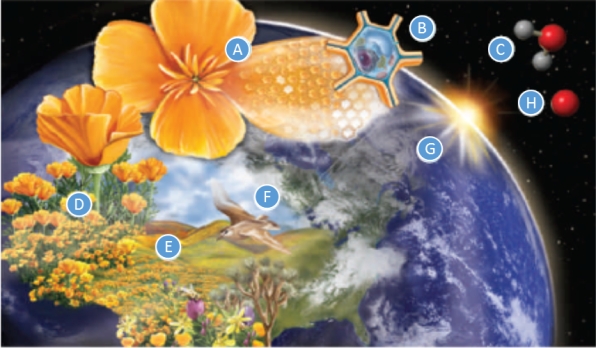A) designing experiments that yield quantitative results
B) performing experiments testing all circumstances
C) reaching conclusions based on personal conviction
D) avoiding questions that may be at odds with society's moral standards
E) publicly publishing their results
Correct Answer

verified
Correct Answer
verified
Multiple Choice
The level of organization that encompasses all regions of Earth's crust, waters, and atmosphere in which organisms live is known as ____.
A) the biosphere
B) a community
C) an ecosystem
D) a population
E) an organism's habitat
Correct Answer

verified
Correct Answer
verified
Multiple Choice
Ernst Mayr was responsible for ____.
A) discovering new species atop New Guinea's Foja Mountains
B) standardizing a two-part naming system
C) explaining the theory of natural selection
D) describing the biological species concept
E) identifying that all organisms contain DNA
Correct Answer

verified
Correct Answer
verified
Multiple Choice
In 1610, which scientist was imprisoned for publishing evidence that the Earth orbits the sun?
A) Aristotle
B) Copernicus
C) Galileo
D) Darwin
E) Newton
Correct Answer

verified
Correct Answer
verified
Multiple Choice
Error bars on a graph indicate ____.
A) places where the data is likely wrong
B) places where the researcher is unsure of his or her results
C) variation in results that cannot be accounted for
D) variation in a set of data around the average
E) poor experimental technique on the part of the researcher
Correct Answer

verified
Correct Answer
verified
Short Answer
Match the term with its definition.  a.atom
b.organism
c.biosphere
d.molecule
e.population
f.ecosystem
g.cell
h.community
-fundamental building block of all matter
a.atom
b.organism
c.biosphere
d.molecule
e.population
f.ecosystem
g.cell
h.community
-fundamental building block of all matter
Correct Answer

verified
Correct Answer
verified
Short Answer
Match the term with its definition.  a.atom
b.organism
c.biosphere
d.molecule
e.population
f.ecosystem
g.cell
h.community
-all populations of all species in a given area
a.atom
b.organism
c.biosphere
d.molecule
e.population
f.ecosystem
g.cell
h.community
-all populations of all species in a given area
Correct Answer

verified
Correct Answer
verified
Multiple Choice
Collectively, which group of organisms are the most diverse representatives of life?
A) plants and animals
B) protists and fungi
C) bacteria and archaea
D) bacteria and protists
E) archaea and plants
Correct Answer

verified
Correct Answer
verified
Multiple Choice
The transmission of DNA to offspring is referred to as ____.
A) homeostasis
B) development
C) growth
D) reproduction
E) inheritance
Correct Answer

verified
Correct Answer
verified
Multiple Choice
Which of the following characteristics are shared by all living organisms? I. Hereditary information is passed to offspring II. Adaptation to environmental change III. Requirement for nutrients IV. DNA housed in a nucleus
A) I and II
B) I and III
C) II and III
D) I, II, and III
E) I, II, III, and IV
Correct Answer

verified
Correct Answer
verified
Multiple Choice
A control group ____.
A) receives the same treatment as the experimental group
B) is an untreated group of individuals or subjects
C) is sometimes exposed to harsh conditions
D) is often an unnecessary waste of material
E) is not subjected to experimental error
Correct Answer

verified
Correct Answer
verified
Multiple Choice
All known species belong to one of three domains. What are these domains?
A) Prokarya, Bacteria, and Eukarya
B) Prokarya, Archaea, and Eukarya
C) Plantae, Bacteria, and Animalia
D) Bacteria, Archaea, and Eukarya
E) Bacteria, Archaea, and Protista
Correct Answer

verified
Correct Answer
verified
Multiple Choice
Which of the following organization levels is the least inclusive?
A) population
B) community
C) cell
D) atom
E) molecule
Correct Answer

verified
Correct Answer
verified
Short Answer
Classification. Answer the following questions in reference to life's diversity. Choose only the most correct answer. -They have no nucleus and are the most numerous organisms on Earth. A)archaea B)bacteria C)Eukarya D)Plantae E)fungi F)animals G)protists
Correct Answer

verified
Correct Answer
verified
Multiple Choice
The current rate of extinction in rain forests is about ____ species every minute.
A) 2
B) 20
C) 200
D) 2,000
E) 20,000
Correct Answer

verified
Correct Answer
verified
Multiple Choice
Homeostasis is ____.
A) the ability to sense and respond to change
B) maintaining the external environment to favor survival
C) essential for nonliving things
D) unique to consumers
E) unique to producers
Correct Answer

verified
Correct Answer
verified
Short Answer
Matching Based on the Olestra potato chip experiment conducted by researchers at the Johns Hopkins University School of Medicine, match the following letters to the number with which they best correspond. -Olestra causes intestinal cramps. A)observation B)hypothesis C)prediction D)experiment E)control group F)experimental group G)the variable H)results I)conclusion
Correct Answer

verified
Correct Answer
verified
Multiple Choice
The emergent property of "life" appears at the level of the ____, when many molecules become organized.
A) population
B) atom
C) organism
D) cell
E) community
Correct Answer

verified
Correct Answer
verified
Multiple Choice
In which of the following groups does seaweed belong?
A) protists
B) plants
C) fungi
D) archaea
E) bacteria
Correct Answer

verified
Correct Answer
verified
Multiple Choice
In the experiment with peacock butterflies, the working hypothesis is that ____.
A) mimicry confuses both predator and prey
B) mimicry protects butterflies from being eaten by predatory birds
C) birds are capable of learning
D) birds are agents of evolution
E) unpalatable species display distinctive wings
Correct Answer

verified
Correct Answer
verified
Showing 61 - 80 of 99
Related Exams